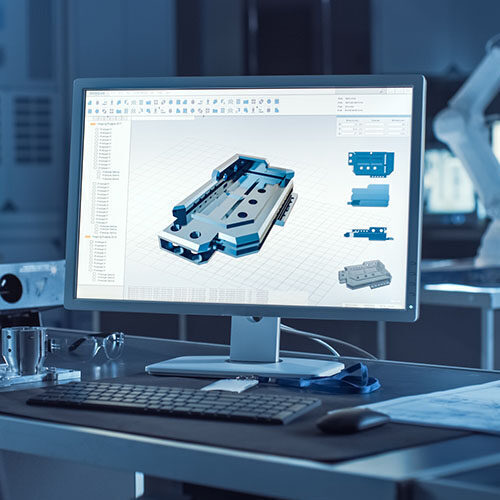
Though purchasing has been a well-defined position in most mid-sized companies, widely accepted standard processes or — even worse — “best” practices have hurt the effectiveness of the department.
In many make-to-order (MTO) environments, a single custom product may be purchased batch after batch. However, very few engineer-to-order (ETO) products get ordered under the exact same specifications again. Therefore, the ETO environment requires logic. Though both industries are similar in some respects, three distinct conditions set a typical engineer to order company apart from an MTO manufacturer:
Marketing & Sales
Since we are focusing on a small and well-defined market, we must separate the material and labour cost from the perceived value that ETO products bring. Business management guru Dr. Goldratt taught us that there are two different perceptions of value:
- The ETO Supplier’s Perception → Cost + Margin = Value of the Product
- The ETO Customer’s Perception → Revenues Gained and/or Reduced Costs and/or ROI = Value of the Product
It is up to marketing — or sales if the engineer to order company does not have a marketing department — to identify the customer’s perception of value. This is the only way the ETO vendor is able to understand the sustainable viability of the engineer-to-order product.
To be considered a viable product and avoid wasting internal resources, the customer’s perception of value must dwarf the ETO vendor’s perceived value. Upon confirming a due date and receiving the first payment, the project is kicked off, which is often followed by chaotic reactive behavior, since the buzzwords in today’s manufacturing landscape are lean and efficient, whereas the requirements of an ETO customer require the opposite – rich and effective.
This difference in methodology leads to contradicting actions and conclusions, where the customer leans in a different direction than the ETO vendor. The ETO vendor focuses on materials and labour plus margin, where the customer’s focus is on minimizing lost revenues or missed opportunities due to lead-time.
For example, if the customer expects that the engineered product (custom equipment) will enable them to produce $80,000.00 of revenue per day, every day they are forced to wait for the product ensures they miss out on $80,000.00 of revenue. Despite a much more complex product structure than that of make-to-stock (MTS) or make-to-order (MTO) manufacturers, the ETO manufacturing process is still expected to deliver quality products with a short and reliable lead-time.
As such, it is important that the sales questions of the engineer to order company compel potential customers to make their specifications clear and that the sales department is able to gather as much information as possible through the use of structured and strategic application questions. These questions should allow for responses that provide extensive insight and definitions that will help the engineering, purchasing and production departments.
Since this information is then shared with engineering, purchasing and production, engineering can adjust technical specifications of long lead-time items, giving the purchasing department a sufficient time buffer to react to actual and well-defined demand.
The Engineering Impact on ETO Purchasing
Assuming engineers are provided structured and detailed information about the product application, it will be easier to define the specifications of to be purchased items and to define and design the product, but even this is often not enough. One of the common occurring conflicts in the engineering department of an ETO environment, is the order in which a product is designed.
Because of this, we need to take a step back and ask ourselves: In what order should the specifications be defined? In what order should the product itself be designed? In my experience, engineering departments usually select the most logical apparent order for assembly. For example: first the chassis, followed by the support beams, then the custom hydraulics, etc.
Though this process may seem compelling, it is not necessarily the most effective order for purchasing or production. Using our previous example of a logical design process, we need to understand that certain components in a product’s design have different purchasing lead-times and production setup times.
The chassis may be readily available as it is fabricated out of steel – a resource that most plants would have in stock or available within a very minimal lead time – while custom hydraulics may have a lead time of 4-8 weeks, and could unexpectedly be delayed, depending on this vendor’s work load.
We could conclude that purchasing should try to better communicate information to engineering, but how can purchasing communicate information about undefined items that they don’t know they have to purchase yet? Some ETO vendors have decided that more meetings at regular intervals, perhaps even paired with yoga and consulting will bring results, or at least relief. Other engineer to order company have settled for today’s results and consider it the nature of our beast or – even worse – a fact of life.
Due to these diverse lead times, engineering must maintain constant and sequential communication with the purchasing department in order to properly respond to changes in demand and lead times.
Purchasing in an ETO Environment
Attempting to predict future sales is unmanageable in ETO environments
Common metrics, sometimes referred to as best practices, often place purchasing in the hot seat, if not the center of demand, and in some cases even blame them for issues, as if they are supposed to have a magic solution to this self-inflicted paradox. This leads to a stressful environment, in which, no matter how much efforts are made, the only option is to execute reactive “buy it right now” requests.
These “buy it right now” requests are sometimes paired with a mandate from top management, stating that purchasing should negotiate an average of ten-percent savings on all purchases for this quarter. This does not necessarily hinder the “buy it right now” mode, but unfortunately its effects are more so noticed in the “receive it much later” that follows the “buy it right now” (while beating up the supplier on pricing, which means the order becomes the supplier’s “least priority” item).
In some environments, for the purchaser to explain these dilemmas, and how these opposing measurements conflict with the desires and its impact on the ETO customer, could very well lead to the reputation of being a complainer and the professional guidance if not reproof to “do a better job”.
In some cases, purchasing is compelled to seek refuge by devising mysterious processes,that should supposedly help them predict the items required for future sales. In most meetings this is referred to as forecasting. Forecasting for ETO is an indication that MTS principles are applied to an ETO environment.
Asking engineering for information in advance may work in some cases, but usually the critical items are undetermined, since the engineers are chasing and confirming information from the customer before being able to validate what should be the item requirements. Even if the item of one kit is defined late, the problem of this will come to haunt purchasing and turn this into a “buy it right now item.”
Even if there was a better way, would this not involve the cooperation of, and synchronization with other departments? How can purchasing be expected to dictate the priorities of other departments? Fortunately, there is an effective purchasing process that requires cooperation and synchronization with every department. That process will be covered in the second part of this blog.
Get your eBook Scared to implement a new ERP?
"*" indicates required fields



